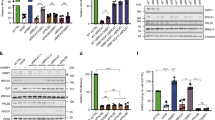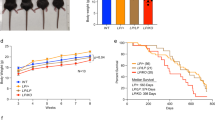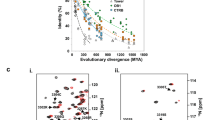Abstract
Homologous recombination mediated by RAD51 recombinase helps eliminate chromosomal lesions, such as DNA double-strand breaks induced by radiation or arising from injured DNA replication forks. The tumor suppressors BRCA2 and PALB2 act together to deliver RAD51 to chromosomal lesions to initiate repair. Here we document a new function of PALB2: to enhance RAD51's ability to form the D loop. We show that PALB2 binds DNA and physically interacts with RAD51. Notably, although PALB2 alone stimulates D-loop formation, it has a cooperative effect with RAD51AP1, an enhancer of RAD51. This stimulation stems from the ability of PALB2 to function with RAD51 and RAD51AP1 to assemble the synaptic complex. Our results demonstrate the multifaceted role of PALB2 in chromosome damage repair. Because PALB2 mutations can cause cancer or Fanconi anemia, our findings shed light on the mechanism of tumor suppression in humans.
This is a preview of subscription content, access via your institution
Access options
Subscribe to this journal
Receive 12 print issues and online access
$189.00 per year
only $15.75 per issue
Buy this article
- Purchase on Springer Link
- Instant access to full article PDF
Prices may be subject to local taxes which are calculated during checkout





Similar content being viewed by others
References
San Filippo, J., Sung, P. & Klein, H. Mechanism of eukaryotic homologous recombination. Annu. Rev. Biochem. 77, 229–257 (2008).
Moynahan, M.E., Pierce, A.J. & Jasin, M. BRCA2 is required for homology-directed repair of chromosomal breaks. Mol. Cell 7, 263–272 (2001).
San Filippo, J. et al. Recombination mediator and Rad51 targeting activities of a human BRCA2 polypeptide. J. Biol. Chem. 281, 11649–11657 (2006).
Tutt, A. et al. Absence of Brca2 causes genome instability by chromosome breakage and loss associated with centrosome amplification. Curr. Biol. 9, 1107–1110 (1999).
Xia, B. et al. Control of BRCA2 cellular and clinical functions by a nuclear partner, PALB2. Mol. Cell 22, 719–729 (2006).
Yu, V.P. et al. Gross chromosomal rearrangements and genetic exchange between nonhomologous chromosomes following BRCA2 inactivation. Genes Dev. 14, 1400–1406 (2000).
Erkko, H. et al. A recurrent mutation in PALB2 in Finnish cancer families. Nature 446, 316–319 (2007).
Foulkes, W.D. et al. Identification of a novel truncating PALB2 mutation and analysis of its contribution to early-onset breast cancer in French-Canadian women. Breast Cancer Res. 9, R83 (2007).
Rahman, N. et al. PALB2, which encodes a BRCA2-interacting protein, is a breast cancer susceptibility gene. Nat. Genet. 39, 165–167 (2007).
Reid, S. et al. Biallelic mutations in PALB2 cause Fanconi anemia subtype FA-N and predispose to childhood cancer. Nat. Genet. 39, 162–164 (2007).
Hirsch, B. et al. Association of biallelic BRCA2/FANCD1 mutations with spontaneous chromosomal instability and solid tumors of childhood. Blood 103, 2554–2559 (2004).
Sy, S.M., Huen, M.S. & Chen, J. PALB2 is an integral component of the BRCA complex required for homologous recombination repair. Proc. Natl. Acad. Sci. USA 106, 7155–7160 (2009).
Zhang, F. et al. PALB2 links BRCA1 and BRCA2 in the DNA-damage response. Curr. Biol. 19, 524–529 (2009).
Modesti, M. et al. RAD51AP1 is a structure-specific DNA binding protein that stimulates joint molecule formation during RAD51-mediated homologous recombination. Mol. Cell 28, 468–481 (2007).
Wiese, C. et al. Promotion of homologous recombination and genomic stability by RAD51AP1 via RAD51 recombinase enhancement. Mol. Cell 28, 482–490 (2007).
Sung, P., Krejci, L., Van Komen, S. & Sehorn, M.G. Rad51 recombinase and recombination mediators. J. Biol. Chem. 278, 42729–42732 (2003).
Gupta, R.C., Folta-Stogniew, E., O'Malley, S., Takahashi, M. & Radding, C.M. Rapid exchange of A:T base pairs is essential for recognition of DNA homology by human Rad51 recombination protein. Mol. Cell 4, 705–714 (1999).
Chi, P., San Filippo, J., Sehorn, M.G., Petukhova, G.V. & Sung, P. Bipartite stimulatory action of the Hop2–Mnd1 complex on the Rad51 recombinase. Genes Dev. 21, 1747–1757 (2007).
Pezza, R.J., Voloshin, O.N., Vanevski, F. & Camerini-Otero, R.D. Hop2/Mnd1 acts on two critical steps in Dmc1-promoted homologous pairing. Genes Dev. 21, 1758–1766 (2007).
Yang, H., Li, Q., Fan, J., Holloman, W.K. & Pavletich, N.P. The BRCA2 homologue Brh2 nucleates RAD51 filament formation at a dsDNA-ssDNA junction. Nature 433, 653–657 (2005).
Yuan, S.S. et al. BRCA2 is required for ionizing radiation–induced assembly of Rad51 complex in vivo. Cancer Res. 59, 3547–3551 (1999).
Walsh, T. & King, M.C. Ten genes for inherited breast cancer. Cancer Cell 11, 103–105 (2007).
Xia, B. et al. Fanconi anemia is associated with a defect in the BRCA2 partner PALB2. Nat. Genet. 39, 159–161 (2007).
Wiese, C. et al. Interactions involving the Rad51 paralogs Rad51C and XRCC3 in human cells. Nucleic Acids Res. 30, 1001–1008 (2002).
Acknowledgements
We are grateful to R. Buisson and J.-Y. Masson (Centre de Recherche du Centre hospitalier universitaire de Québec) for the communication of results before publication, to S. Begovic, S. Longerich and Y.-C. Kim (Yale University) for assistance, to Y. Kwon (Yale University) for providing ScRad51 protein and to B. Xia (Department of Radiation Oncology, The Cancer Institute of NJ) for providing PALB2-deficient and PALB2-complemented cells, as well as for providing PALB2 antibody. This study was supported by research and program project grants RO1CA120315, RO1ES07061, RO1ES015252, RO1ES015632, PO1CA129186 and PO1CA92584 from the US National Institutes of Health and by postdoctoral fellowship PDF0706844 from the Susan G. Komen for the Cure Foundation.
Author information
Authors and Affiliations
Contributions
E.D., J.E. and C.W. conceived and carried out experiments; E.D. and C.W. also wrote the paper. D. Saro, G.J.W., M.H., X.Y., V.E.G., C.W., D.L., M.-S.T. and S.M.-H.S. contributed key material. D. Schild, E.E., J.C. and P.S. contributed expertise. P.S. provided guidance throughout, wrote and edited the paper.
Corresponding authors
Ethics declarations
Competing interests
The authors declare no competing financial interests.
Supplementary information
Supplementary Text and Figures
Supplementary Figures 1–7, Supplementary Table 1 and Supplementary Methods (PDF 3812 kb)
Rights and permissions
About this article
Cite this article
Dray, E., Etchin, J., Wiese, C. et al. Enhancement of RAD51 recombinase activity by the tumor suppressor PALB2. Nat Struct Mol Biol 17, 1255–1259 (2010). https://doi.org/10.1038/nsmb.1916
Received:
Accepted:
Published:
Issue Date:
DOI: https://doi.org/10.1038/nsmb.1916
This article is cited by
-
RAD51 is a poor prognostic marker and a potential therapeutic target for oral squamous cell carcinoma
Cancer Cell International (2023)
-
Functional assessment of missense variants of uncertain significance in the cancer susceptibility gene PALB2
npj Breast Cancer (2022)
-
The Greatwall kinase safeguards the genome integrity by affecting the kinome activity in mitosis
Oncogene (2020)
-
Structural basis of homologous recombination
Cellular and Molecular Life Sciences (2020)
-
DNA damage response and repair in perspective: Aedes aegypti, Drosophila melanogaster and Homo sapiens
Parasites & Vectors (2019)



